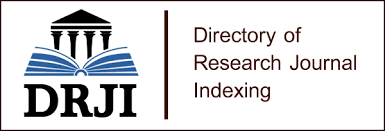MOTIVATION MATTERS IN ADOPTING PREWRITING STRATEGIES AND IMPROVING WRITING ACHIEVEMENT AMONG BANGLADESHI ADULT EFL LEARNERS
Abstract
To state the benefits of prewriting activity Schweiker-Marra (2000) stated that students writing anxiety can be minimized through a writing program that emphasizes prewriting activities. But the ability of choosing an appropriate planning for a particular writing task is necessary for a satisfactory result. At the same time learners experiencing difficulties with prewriting activity are needed to be motivated and encouraged to use various strategies for improving their writing. The aim of this article is to show (1) whether the explicit instruction could motivate the ESL learners to use prewriting strategies and (2) whether the instruction on prewriting strategies can help students improving their writing style. Data were drawn from 40 EFL university students before and after an explicit instruction program lasted for 10 classes (75mins each). To determine relationships between writing strategies instruction program and learners writing achievement, a t-test analyses was used. Result shows, motivational incentives are needed to apply while teaching writing strategies and only a well-planned pre-writing activity can help EFL learners in overcoming the writing block and aid them successfully to prove their creativity and individuality. Â
References
Al-Shaer, I.M. R (2014). Employing Concept Mapping as a Pre-writing Strategy to Help EFL Learners Better Generate Argumentative Compositions. IJSOLT, 8(2).Retrieved from http://digitalcommons.georgiasouthern.edu/ij-sotl/vol8/iss2/1.
Blackburn-Brockman ,E. (2001) .Critical Approaches to Teaching Literature Language Composition and Culture. Pedagogy Winter (1): 167-168; doi:10.1215/15314200-1-1-167
Chamot ,A. U.( 2004). Issues in Language Learning Strategy Research and Teaching. Electronic Journal of Foreign Language Teaching .1( 1), pp. 14-26. Retrieved from http://e-flt.nus.edu.sg/.
Chapman, J. W., Tunmer, William E., & Prochnow, J. E. (2000). Early reading-related skills and performance, reading self-concept, and the development of academic self-concept: A
longitudinal study. Journal of Educational Psychology, 92: 703-708.
Cutler, L. (2008). Primary grade writing instruction: a national survey. Journal of Educational Psychology, 100(4): 907-919.
Deci, E., & Ryan, R. (1985). Intrinsic motivation and self-determination in human behaviour. New York: Plenum.
Deng, L. et al. (2003).A Systematic Study of Process Approach and Its Implications for the
Teaching Reforms of College English Writing. Foreign language Education, 6: 58-62.
Dexter, D. and Hughes, C. (2011). Graphic organizers and students with learning disabilities: a
meta-analysis. Learning Disability Quarterly, 34(1), 51-72.
Dibello, C. & Ting-shu,W. (2007). Composing Our World Taipei : Book man Company.
DÖrnyei Z. (2006). Individual differences in second language acquisition. AILA Review, 19: 42-68.Sullivan IO. 2006. Learners’ writing skills in French: Corpus consultation and learner evaluation. Journal of Second Language Writing, 15(1): 49-68.
Dörnyei, Z. & Csizér, K. (1998). Ten commandments for motivating language learners: results of an empirical study. Language Teaching Research 2 (3) , 203 –229.
Dujsik, D. (2008). The effects of pre-writing strategy training guided by computer-based procedural facilitation on ESL students’ strategy use, writing quantity, and writing quality (Unpublished doctoral dissertation).University of South Florida, Tampa, Florida.
Fry, S. and Griffin, S. (2010). Fourth graders as models for teachers: teaching and learning 6+1 trait writing as a collaborative experience. Literacy Research and Instruction, 49, 283-298.
Go AS (1994). Prewriting activities: Focus on the process of writing. Eric, ED369257.
Graham, S., & Perin, D. (2007).Writing next: Effective strategies to improve writing of
adolescents in middle and high schools – A report to Carnegie Corporation of New York.
Washington, DC: Alliance for Excellent Education.
Grisham, D. and Wolsey, T. (2011). Writing instruction for teacher candidates: strengthening a weak curricular area. Literacy Research and Instruction, 50: 348-364.
Gupta, D., & Woldemariam, G. S. (2011). The influence of motivation and attitude on writing strategy use of undergraduate EFL students: quantitative and qualitative perspectives. The Asian EFL Journal Quarterly,13(2).
Gattis,K.W. (1998). Importance of students verbalization. Science Junction, Raleigh, NC: North
Carolina State University. Retrieved from
www.ncsu.edu/sciencejunction/route/professional/verbal.html .
Hatasa,Y. & Soeda, E. (2000). Writing strategies revisited: A case of non-cognate L2 writers. In
B. F. Swierzbin, M. E. Morris, C. Anderson, A. Klee, & E. Tarone (Eds.),Socialand
cognitive factors in second language acquisition. Somerville, MA: Cscadilla Press.
Hennessy, D., & Evans, R. (2005). Reforming writing among students in community colleges.
Community College Journal of Research and Practice, 29(4): 261-75.
Krashen, S. D. (2011). Protecting Students against the Effects of Poverty. Libraries:New England Reading Association Journal. 46 (2): 17-21
Knowles, M. S., Holton, E. F., & Swanson, R. A. (2005). The adult learner (6th ed.). Burlington,
MA: Elsevier Butterworth-Heinemann.
LaRoche, K.M. (1993). A focus on using prewriting and knowledge level strategies and skills to improve the attitudes and writing skills of middle school students. Eric, ED366974.
Lo, J. & Hyland,F. (2007). Enhancing students’ engagement and motivation in writing: The case of primary students in Hong Kong. Journal of Second Language Writing, 16 : 219–237.
doi:10.1016/j.jslw.2007.06.002.
Lopez-Nerney, S., & Binder, C.A. (2003). Motivating students in a writing class ( CDTLink Vol.
, pp. 3-4). Singapore: National University of Singapore.
Maftoon, P.& Rabie, M. (2007). Responding to students’ writing: EFL students reaction to teachers’ written/oral response in one-draft only composition classroom. Journal of Teaching English Language and Literature Society of Iran,1 4:1-22.
Mahnam , L. & Nejadansari , D. (2012). The Effects of Different Pre-Writing Strategies on Iranian EFL Writing Achievement. International Education Studies. 5 ( 1). doi:10.5539/ies.v5n1p154.
Malgorzata Adams-Tukiendorf (2008). Overcoming Writer’s Block. Paper presented in an MA
Seminar, University of Opole, Poland. Retrieved from www.zeitschrift-schreiben.eu.
Manchón, R. M., Roca de Larios, J. & Murphy, L. (2007). A review of writing strategies: Focus on conceptualizations and impact of first language. In A. D. Cohen & E.Macaro (Eds.),Language learner strategies: Thirty years of research and practice . 229-250. Oxford: Oxford University Press.
Mekheimer M. 2005. Effects of Internet-based Instruction, Using Web questing and E-mailing
on Developing Some Essay Writing Skills in Student Teachers. Unpublished doctoral
dissertation, Cairo University.
Meihami, H. & Varmaghani, Z . (2013). The Implementation of Self-Assessment in EFL
Writing Classroom: An Experimental Study. International Letters of Social and Humanistic Sciences ,9 : 39-48.
Mills, N., Pajares, F., & Herron, C. (2006). A Reevaluation of the Role of Anxiety: Self-Efficacy, Anxiety, and Their Relation to Reading and Listening Proficiency. Foreign Language Annals, 39(2):276-294.Retrived from http://dx.doi.org/10.1111/j.1944-9720.2006.tb02266.x.
Mitcham, K. (2009). Teaching for the fun of it. English Journal, 98 (6): 13-14.
Mohseniasl, F.( 2014). “Examining the effect of strategy instruction on writing apprehension and writing achievement of EFL learners,†Theory and Practice in Language Studies, 4:811-817.
Noels KA, Clement R. (1996). Communication across Cultures: Social Determinants and
Acculturative Consequences. Canadian Journal of Behavioral Science, 28: 214-228.
Richard, J. C. & Rodgers, T. S. (2001). Approaches and Methods in Language Teaching. (2nd ed.) .Cambridge: Cambridge University Press .
Sasaki, M. (2002). Building an empirically-based model of EFL learners’ writing processes. In S. Ransdell &M. L.Barbier (eds.), New directions for research in l2 writing. Dordrecht: Kluwer Academic Publishers.
Sasaki, M. (2000). Toward an empirical model of EFL writing processes: an exploratory study.
Journal of Second Language Writing, 9(3): 259-91.
Schaefer, L.(2011). Time to Rethink the Teaching of Writing. Retrieved from www.reading.org/.../bk099-1-culham.pdf
Schweiker-Marra K, Marra ,W. (2000). Investigating the effects of prewriting activities on writing performance and anxiety of at-risk students. Read. Psychol. 21(2):99-114.
Shafiee, S. (2010, October). Reverse Strategy Transfer from EFL Learners’ L2 Experience to
their L1 Writing Tasks. Paper presented at the Eights TELLSI Conference, Alzahra
University, Tehran, Iran.
Smith, L . (2001, November 11). Implementing the reading-writing connection .
Retrieved from http://www.umkc.edu/cad/nade/nadedocs/98conpap/lscpap98.htm .
Talebinezhad, M.R., & Negari, G. M. (2007). The effect of explicit teaching of concept mapping in expository writing on EFL students’ self-regulation. Pazhuhesh- e Zabanha-ye Khareji, 42: 85-108.
Tarnopolsky, O. (2000). Writing English as a foreign language: A report from Ukraine.
Journal of Second Language Writing,9(3):209-226.
Tompkins GE (2001). Literacy for the 21st century: A balanced approach. Columbus, OH:
Merrill Prentice Hall.
Tompkins, G. E. (1990). Teaching Writing: Balancing Process and Product. Columbus: Merrill. Williums, M. & Burden, R. (1997).Psychology for Language Teachers. Cambridge :Cambridge
University Press.
Published
How to Cite
Issue
Section
License
Copyrights for articles published in Journal of Asian and African Social Science and Humanities are retained by the authors, with first publication rights granted to the journal. The journal/publisher is not responsible for subsequent uses of the work. It is the author's responsibility to bring an infringement action if so desired by the author.
Articles published in Journal of Asian and African Social Science and Humanities are published under the Creative Commons Attribution (CC-BY) license, which permits others to distribute, remix, tweak, and build upon your work as long as they credit you for the original creation.
Â














